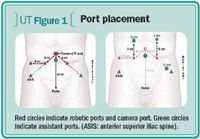Article
Robot-assisted cystectomy for bladder cancer: What are the advantages?
This article discusses the advantages of RARC versus open cystectomy, and outlines unanswered questions concerning the application of the robotic approach.



Preoperative evaluation includes a thorough history and physical examination to determine clinical stage of the disease. In addition, previous surgical history and any history of pelvic radiation therapy are elucidated. Also, a patient with significant pulmonary disease may not be able to tolerate steep Trendelenburg position and abdominal insufflation. A history of previous bowel surgery or radiation therapy may not be a contraindication to RARC based on the surgeon's experience. Neoadjuvant chemotherapy is not a contraindication to RARC.
Previously, mechanical bowel preparation was used preoperatively, but our group recently eliminated mechanical bowel preparation from our preoperative preparation. Patients are allowed to eat a regular diet prior to surgery and only receive a neomycin enema and perioperative antibiotics. Patients with a history of complex bowel surgery or radiation therapy may still be prescribed a preoperative bowel preparation. We recently conducted a retrospective review of 40 patients who underwent standard preoperative bowel preparation with magnesium citrate and clear liquid diet and 35 patients in whom mechanical bowel preparation was eliminated. There were no significant differences in overall complications or gastrointestinal complications (ileus, obstruction, abscess, anastomotic leak) in patients who did not undergo preoperative mechanical bowel preparation (unpublished data).

Initially, extended pelvic lymphadenectomy is performed and is carried proximally at least to the mid-portion of the common iliac vessels. More proximal dissection to the aortic bifurcation and even to the level of inferior mesenteric artery is feasible, if desired. Dissection is carried distally to include the obturator nodal packet and internal iliac packet. Alternatively, lymphadenectomy can be performed after removal of the bladder.
Following lymphadectomy, the ureters are dissected proximally along the psoas muscle and distally to the level of the bladder. The ureters are then clipped and transected. The dissection is then directed to the lateral perivesical space to expose the endopelvic fascia. The endopelvic fascia is then incised and the levator muscle fibers are dissected off the prostate. The bladder should remain attached anteriorly to allow for adequate posterior dissection. The peritoneum posterior to the bladder is then incised and the vasa deferentia are identified and followed to the seminal vesicles. Once the seminal vesicles are isolated, Denonvillier's fascia is incised and the prerectal space is entered. Dissection is then carried distally posterior to the prostate toward the apex.





